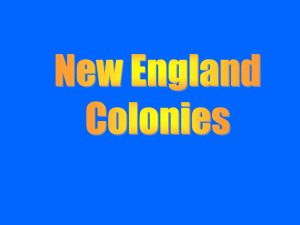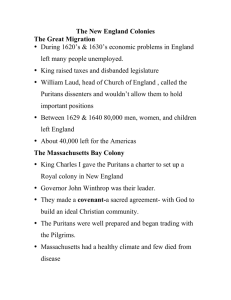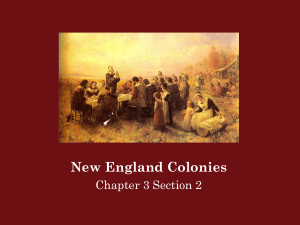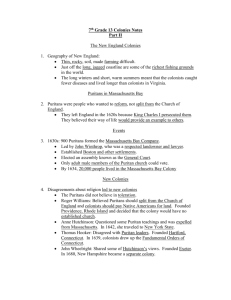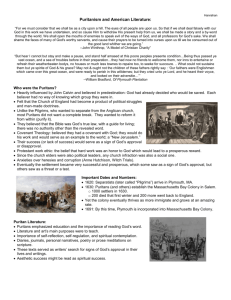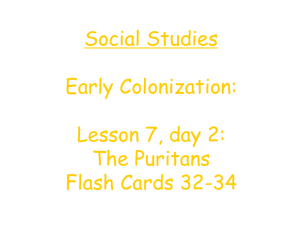A Gathering of voices
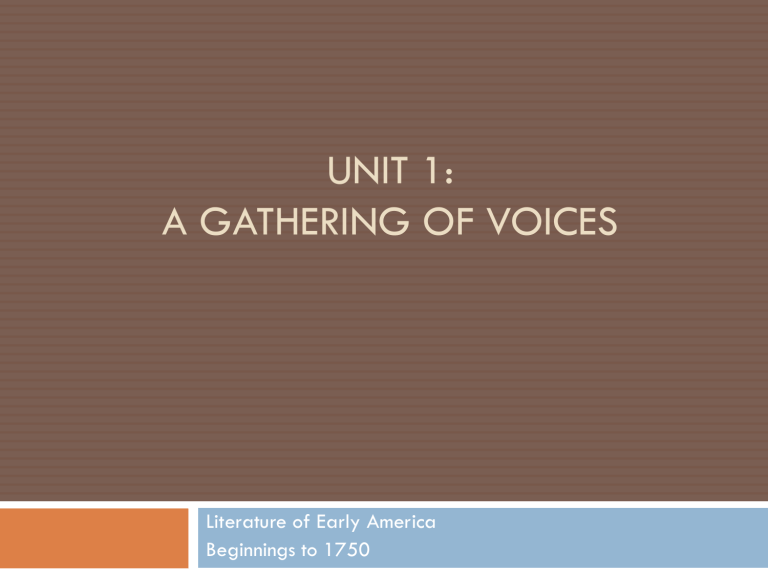
UNIT 1:
A GATHERING OF VOICES
Literature of Early America
Beginnings to 1750
“We shall be as a City upon a Hill, the eyes of all people are upon us; so that if we shall deal falsely with our God in this work we have undertaken and so cause him to withdraw his present help from us, we shall be made a story and a by-word through the world.”
John Winthrop
Governor of the Massachusetts Bay Colony
So…why should we study American
Literature?
Because it’s more than just studying about major
American writers.
It’s more than just reading about major literary movements that shaped this nation.
It’s even more than just learning how history and cultural events shaped the writers of the past.
It’s about….
Learning how you feel, how you react, and how you respond to the literary, historical, and cultural movements of yesterday….
It’s about learning how take those events from yesterday and using them to become better men and women…
So that one day you can be the writers, leaders, and great thinkers that our children read, analyze, and write about tomorrow.
Questions for Consideration
Who is an American?
What is American literature?
When does “American” literature begin?
Who is great and who is not so great?
What forces shaped American writers?
What is an American?
Are Christopher Columbus and
John Smith Americans?
Are early Native American tales
American literature?
Were the Puritans Americans?
Was Thomas Paine an American writer?
First Explorers and Settlers
Columbus, Smith, early missionaries and early settlers thought of themselves as Europeans
They thought, wrote, acted, and worked as and for
Europeans
Columbus wrote as propaganda, to gain more funding and political backing for his trips
Smith also wrote for propaganda purposes: to gain backing and settlers
The First Americans
When Chris Columbus reached North America in 1492, the continent was already populated by several Native
American tribes.
Though unknown when the first Americans came to what is now the United States, Native Americans have been here
30x longer than their European counterparts
What were they doing all that time? No one really knows.
What we do know is that they treated the Europeans as friends.
Pilgrims and Puritans – Farmers and Religious
Reformers
Pg. 7-8
Small group of Europeans sailed on the Mayflower in 1620.
Religious reformers known as Puritans
Became critical of the Church of England
Instead of “purifying” within, they chose to withdraw
Established settlement in Plymouth Massachusetts
Believed human beings exist for glory of God and
Predestination
Massachusetts Bay Colony founded by religious reformers – still apart of Church of England
Pilgrims and Puritans – Farmers and Religious
Reformers
The Southern Planters
Southern Colonies differed from New England colonies
Climate, crops, social organization, and religion
Prosperous costal cities grew up in the South
Beyond the cities lay large plantations
Plantation: a large scale agricultural enterprise and center of commerce
1 st Black Slaves were brought to Virginia in 1619
A year before Plymouth Rock
By 1750, Puritanism was out and the plantation system was a way of life.
Literature of the Period
An odd melting pot
The Melting Pot pg. 9-13
Native American Tradition
Viewed mainly as folklore
95% oral – no fixed versions exist
Famous orators
Logan and Red Jacket
The Puritans
Writing dominated Puritan’s life
Consisted of theological studies, hymns, and histories
Anne Bradstreet and Edward
Taylor
Explorer’s Accounts
Christ Columbus backed by
Queen Isabella set sell in 1492
Wrote his experience in his
Journal of the First Voyage to
America
Southern Writers
John Smith
Wrote The General History of
Virginia
John Byrd
The History of the Dividing
LIne
Names and Terms to Know pg. 3
Christopher
Columbus
Massachusetts Bay
Colony
Anne Bradstreet
Native Americans
The Great
Awakening
Edward Taylor
Puritans and Pilgrims
Explorers’ Accounts
John Smith
Important Dates to Remember p. 4-5
1492
Christopher Columbus lands in the Bahamas
1565
1 st permanent settlement in U.S. established in Florida by Pedro Menendez
1586
English Colony at Roanoke Island disappears; known as the Lost Colony
1590
Iroquois Confederacy established to stop warfare among the Five Nations
Important Dates to Remember….
Pg. 4-5
1607
1 st permanent English settlement at Jamestown, Virginia
1619
1 st Black Slaves brought to Virginia
1636
Harvard College founded in Massachusetts
1639
First printing press in English-speaking N. America arrives in
Massachusetts
1692
Salem witchcraft trials result in execution of 20 people
1741
Great Awakening, a series of religious revivals begins to sweep the colonies
Are you still with me?
Name 3 key developments in colonial life?
Founding of Harvard University
First permanent English settlement
First printing press
What was the cause of the of executions in 1692
People were convicted of witchcraft
Susan Power – Native American
Writer and Poet
Born in Chicago, Susan Power was greatly influenced by parents representing two distinct cultures. Her mother: Native American. Her father: A descendent of the New Hampshire governor of the Civil War.
What we’ll be reading
The Earth on Turtle’s Back - Onondaga
When Grizzlies Walked Upright - Modoc
from The Navajo Origin Legend – Navajo
from The Iroquois Constitution - Iroquois
Museum Indians – Susan Powers
A Journey Through Texas
About:
Early Native American Literature
Background
There were more than 2000 independent tribes of about one million natives, living here for about 2000 years already.
They spoke 500 different languages from 50 different language groups. But, no Indian tribes had a written language until Sequoyah invented a syllabary for the
Cherokees in 1821.
Different tribes had different literary tastes. The Sious preferred war tales; the Ojibwas preferred stories about sex; and the Menominis liked tales of the supernatural.
Styles of Native American Writings
The Oral Tradition Links the Past with the Present
The Art of Storytelling….
How Native American retold History
Through Song
Dakota Indians at a chief’s funeral would sing the life and accomplishments at the chief’s funeral
Sacred Symbols on Tanned Hides
Literary religious scriptures were placed on tanned hides or stone tablets to ensure customs and religious traditions
Winter Count
Indian version of a history book
Tanned buffalo hide with symbols, one picture for each year to represent the most significant event during that year
Oral Tradition
Earliest form of American Literature
Native Americans:
Two Literary Traditions – 1 Culture
The Oral Tradition
Begins earlier in time
Requires language but not a system of writing
Based on memory
Includes folklore, proverbs, and chants
Uses strong rhythms and repetition to help memory
Orator can vary presentation in response to audience
The Written Tradition
Begins later in time
Requires language and system of writing
Based on texts that can be written, read, & copied
Includes novels, short stories, history books
No variation
Materials fixed in a single version
Literary Analysis Term:
Origin Myths
Origin myths
Tradition Stories that recount the origins of earthly life.
Passed down from generation to generation,
Often explain phenomena:
The beginning of human life,
The customs and religious rites of a people
The creation of natural landmarks
Events beyond a people’s control
Reading Strategy
Recognize Cultural Details
Literature reflects the culture that produces it.
When we read the three Native American myths there are several cultural details that indicate how the Native Americans lived as well as what they valued.
When you read, you need to begin to pay attention to cultural details:
References to objects, animals, or practices that signal how people live, think, or worship
You do this to gain insight into their culture
